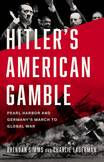Review: America’s two-front dilemma in World War II
An embattled European democracy fights to survive an onslaught of authoritarian aggression. The United States rushes weapons and ammunition to the frontlines across the Atlantic yet remains careful to avoid entering the conflict itself. Meanwhile, at home, self-described “America First” politicians raise objections to sending so much military assistance to Europe. Would this not risk involving us in the war directly? Many also point to a rising threat in the Pacific as the real enemy. Can America really spare so much of its own equipment and ammunition stores for Europe with war brewing in Asia?
This discussion will be familiar to those who have been following the ongoing debate on how to balance the United States’ commitment to helping Ukraine repel Russia’s invasion with matching China’s military buildup in the Pacific, especially around Taiwan. Yet it also describes the strategic debate over 80 years ago, on the eve of Japan’s attack on Pearl Harbor and in the nerve-wracking days that followed. This story is told in Hitler’s American Gamble, an excellent work by the historians Brendan Simms and Charlie Laderman. Books about World War II are ubiquitous in the nonfiction section, but this is the rare recent work with a genuinely new contribution to make, not just to our understanding of the past but also to our understanding of the present.
Contrary to what you may think you remember from history class, the Japanese attack on Dec. 7, 1941, did not immediately or automatically bring the United States into the war in Europe. Though hindsight has made the United States going to war with Germany seem inevitable, at the time there was every reason to believe Pearl Harbor would draw American attention away from Europe. With the U.S. Pacific Fleet devastated, Winston Churchill, Joseph Stalin and even Franklin Roosevelt himself were all concerned that the Japanese attack would force an end to critical U.S. Lend-Lease assistance to the British and Soviets, as those supplies were needed in the Pacific. The United States might well have waged a separate, parallel war against Japan, effectively abandoning Europe to the Nazis. If Hitler had not declared war on the United States himself, there is every reason to believe it could have played out that way.
It would not be until Dec. 11 that Germany declared war on the United States (and not the other way around). Simms and Laderman’s book is the story of the five agonizing days from Pearl Harbor to America finally entering the war against Hitler, told in real time, hour by hour, across all the world’s time zones. These are the five days that really shaped the course of the war, finalizing the two sides’ previously shifting coalitions and merging the war in Asia with the war in Europe into the one big conflict we remember today. It was not Pearl Harbor itself but how all the major players reacted that would truly make it a world war.
Each chapter of Hitler’s American Gamble covers one day, beginning at midnight in London. We spend time with all the major characters and decision-makers and follow the flow of information and memos among foreign embassies and diplomatic ministries. (I once worked in the U.S. State Department, where my duties included occasionally sprinting down hallways with a lock bag full of classified documents, so following the rhythms of the churning bureaucracies was a highlight in the book for me.)
Yet the authors thankfully also spend lots of time with regular people. We meet German soldiers on the Eastern Front, Jewish civilians in occupied Europe and many a proverbial man on the street, from London, Tokyo, New York and elsewhere. We hear how the American public debated the link between Germany and Japan and whether Pearl Harbor was a reason to oppose Hitler even more, or instead to withdraw aid from the British and the Soviets.
Of particular interest were the narratives of two different American convoys who were at sea during this fateful week. One navigated the treacherous Arctic Ocean in near-total darkness, carrying American Lend-Lease aid from Iceland to the Soviet Union. For all his bluster about World War II, Vladimir Putin forgets how essential U.S. aid was to the Soviet war effort, and how American ammunition, tanks, planes and fuel kept the Soviets in the war against Germany, just like American aid has kept Ukraine in the war against Putin today.
The other convoy consisted of U.S. ships ferrying British troops to Cape Town, South Africa. They were going the long way from Britain to the North African front, going all the way around the African continent to join the fight in Egypt. But Pearl Harbor and the subsequent Japanese attack on the Western European colonies in Asia would see them rerouted—sailing across the Indian Ocean to join the fight in the Pacific instead.
Other forgotten episodes are brought back to life in minute detail. As a Californian, I found the descriptions of the war scares on the West Coast, when San Francisco and Los Angeles became convinced they were under attack by Japan, particularly interesting. Steven Spielberg would later make this the subject of his ill-fated World War II slapstick comedy “1941.” In much-less-funny real life, these anxieties would give rise to racial injustices like Japanese internment and the anti-Mexican Zoot Suit Riots. But at the time, California seemed to call out for aid, with the crippled U.S. Pacific Fleet unable to defend it. California’s rescue, though, would have to come at Europe’s expense.
Above all else, what breaks through in the book is just how much the United States wanted to avoid a two-front war. Prior to Pearl Harbor, Roosevelt was even open to exploring some sort of accommodation with Japan in order to focus on delivering aid to the Allies. When Pearl Harbor came, it was the worst outcome imaginable, forcing Roosevelt into the war he did not want to fight at the expense of the Lend-Lease assistance he had fought so hard to give. The America First proponents were ready to see in the war against Japan the best argument yet for peace with Germany.
It is hard to escape the racial implications. Just as Japan saw itself as striking a blow against white rule in Asia, many xenophobic and antisemitic isolationists in the America First movement were perfectly willing to fight Japan to preserve American power in Asia but seemed to sympathize with Hitler. There is a strange echo in how so many of Donald Trump’s latter-day America First followers seem to relish confrontation with China, all while strangely sympathizing with Russia. Yet in the aftermath of Pearl Harbor, with the Navy in ruins, Roosevelt dared not directly confront them by declaring war on Germany himself.
So why did Hitler then give Roosevelt a way out? The long story short is that he had promised Japan he would declare war on the United States if Japan did so first, as a way of encouraging the Japanese attack. Hitler wanted above all else to redirect America’s immense production capacity, which was keeping Britain and the Soviet Union alive. He was happy to declare war on the United States, believing it the necessary price to bog down U.S. forces in the Pacific. It seems it never occurred to him that Roosevelt would simply prioritize the European Theater anyway, agreeing on a “Germany first, Japan second” strategy with Churchill and Stalin. It would be Hitler’s downfall.
Today, the United States again confronts a two-front war debate. The U.S. military is increasingly concerned about the impact aid to Ukraine will have on its own readiness, while American diplomats and internationalists fear the consequences of letting Putin’s war of aggression succeed. The United States is already investing significant effort and resources into increasing defense production to meet Ukraine’s needs. A lesson of both the book and the current conflict in Ukraine is just how much grand strategy in war is shaped not just by tactical success on any specific battlefield but by the big picture of production and logistics.
World War II was won in the factories and fields of America, which powered and fed a global war effort from the islands of the South Pacific to the fields of Ukraine. As war looms over these places yet again, the most important question in U.S. foreign policy is also a familiar one: Can America produce its way out of a two-front dilemma?
This article also appeared in print, under the headline “America’s Two-Front Dilemma,” in the June 2024, issue.











